You know that feeling when you make a gorgeous salad and it turns into a soggy mess after a few hours? This happened to me so many times until I found the perfect 7 layer salad recipe. The best part? It stays fresh for a full 24 hours.
This classic 7 layer salad has become my reliable choice for potlucks and family gatherings. The recipe’s magic lies in its sma
rt layering technique that keeps everything crisp and fresh. The salad works great as an overnight dish and maintains its texture and flavor. This makes it ideal for busy hosts who need to prepare food ahead of time.
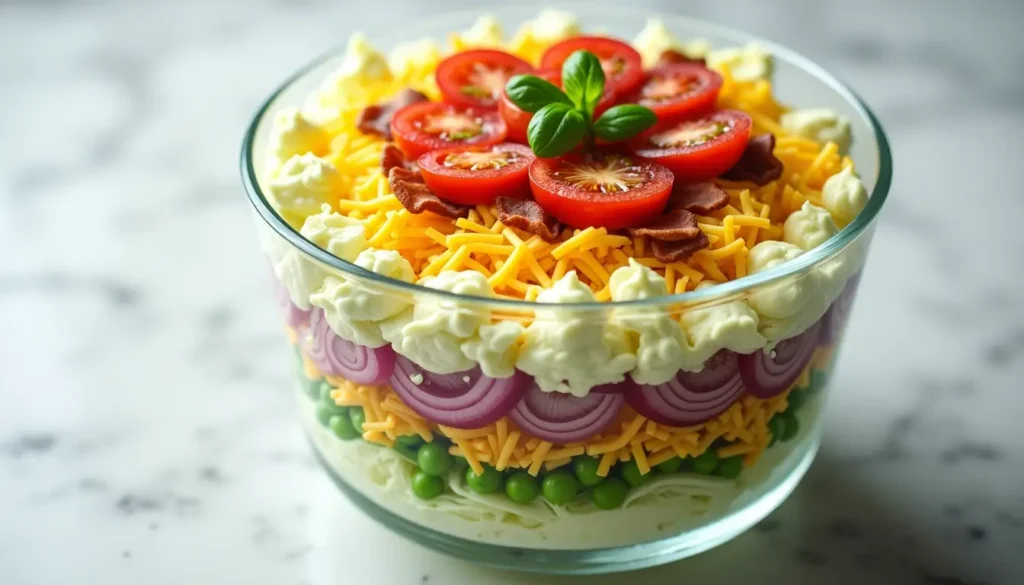
Let me show you the science behind proper layering and the right ingredients. You’ll learn assembly techniques and storage methods that ensure crispy, fresh salads. My tested tips will help you create this make-ahead dish that your guests will love.
Table of Contents
The Science Behind Perfect Layering
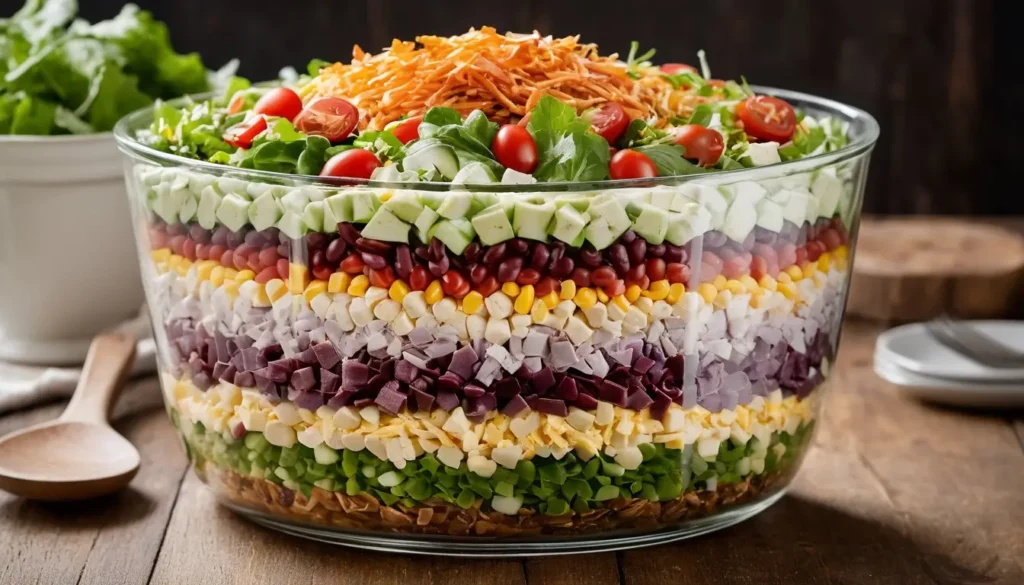
The perfect 7-layer salad needs more than just stacking ingredients – it’s a science that will give a fresh and crisp result in every layer. Let me share the sort of thing i love about the science behind this classic dish.
Why Layer Order Matters In 7 Layer Salad Recipe
Our traditional 7-layer salad recipe’s success depends on smart ingredient placement. I found that there was one golden rule – keep the dressing away from delicate ingredients. Sturdy vegetables must act as barriers between wet and dry components.
Here’s the optimal layering sequence I follow:
- Dressing (bottom layer)
- Hearty vegetables (barrier layer)
- Proteins and grains
- Less sturdy vegetables
- Delicate greens (top layer)
Moisture Control Principles
Moisture management is a vital part of making our overnight layered salad work. I make sure each ingredient is completely dry before assembly. The dressing works as an emulsion – a temporary mixture of oil and water that needs proper handling.
The fascinating thing I learned is that egg yolks in mayonnaise-based dressings contain phospholipids that help create a remarkably stable emulsion. These stable emulsions can still split if not layered properly.
Temperature Considerations
Temperature plays a key role in keeping our 7-layer salad fresh. My experience and research show that storing the salad at 4°C leads to nowhere near 1% waste within seven days. Storage at 12°C makes waste jump dramatically to 13%.
The best storage temperature range sits between 34-38°F (1-3°C). These temperatures slow down wilting while keeping the salad looking appealing. On top of that, it helps stop microbial growth that could affect both safety and quality.
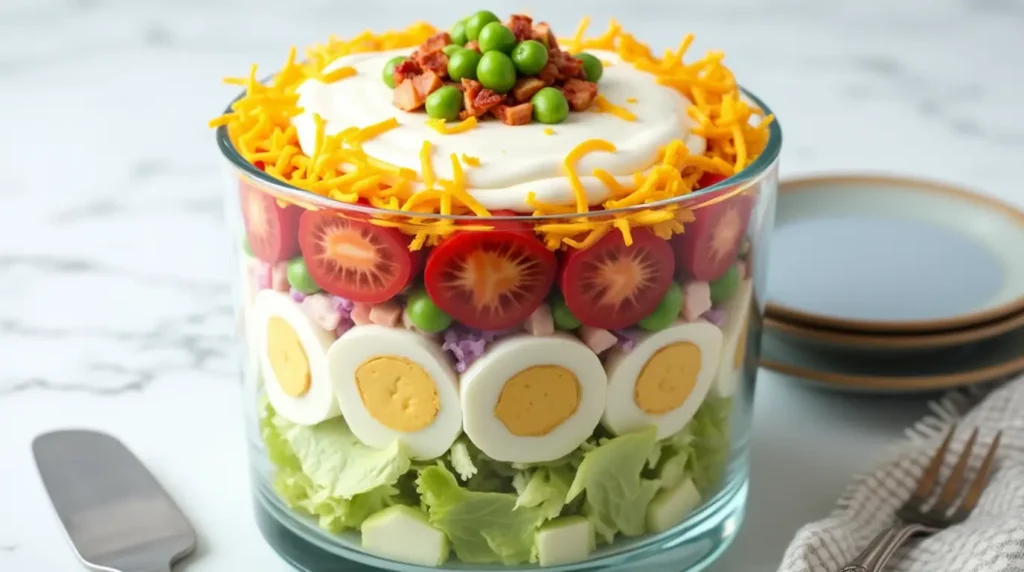
Essential Ingredients and Their Roles
Let’s take a closer look at everything in our 7 layer salad that makes it a soaring win. Selecting the right ingredients and understanding their roles is a vital part of creating a salad that stays fresh overnight.
Barrier Layer Components
Our traditional 7 layer salad recipe begins with sturdy vegetables that create significant moisture barriers. Crisp iceberg lettuce works best as the base layer. This variety stays firm and resists wilting. The next layer consists of frozen peas – here’s a pro tip: thaw and drain them well first.
Moisture-Rich Ingredients
The middle layers need ingredients that require protection from both top and bottom. These are the core components I use:
- Red onions (no more than one cup so other flavors shine)
- Cherry or grape tomatoes (whole, not sliced)
- Celery to add crunch
- Hard-boiled eggs that bring protein richness
Protective Toppings
The top layers protect everything underneath. The mayonnaise layer serves as an excellent moisture barrier for cheese and bacon. You’ll get the best results with:
- Plain, high-quality mayonnaise like Hellman’s or Best Foods
- Sharp cheddar cheese (smoked provolone or feta work great too)
- Crispy bacon pieces as the final touch
These variations add extra flair:
- Mix half mayo and half sour cream for a tangier taste
- Add freshly grated Parmesan to the mayo mixture
- Include extra vegetables like bell peppers or artichoke hearts
Yes, it is the specific role of each ingredient that makes this overnight layered salad special. The mayo dressing creates a “seal” on top that keeps everything crisp. The protective layer should extend to the edges of your serving bowl.
Some ingredients need special attention. Salt pulls moisture from vegetables and creates unwanted liquid pooling. You should also keep soft cheeses separate until serving time to preserve their texture.
Mastering the Assembly Process
Let me share my proven assembly techniques to make the perfect 7 layer salad. Years of practice taught me that success comes from putting everything together just right.
Proper Layer Thickness
A well-balanced 7 layer salad recipe needs proper proportions. The lettuce layer should be twice as thick as other layers to get the best ingredient ratio. I place ingredients around the bowl’s perimeter and fill the center with extra lettuce or spinach. This creates a stunning visual display.
You need a clear glass bowl or trifle dish to show off your layering skills. A bowl with straight sides makes assembly much easier.
Sealing Techniques
The sealing process is a vital part of creating an overnight layered salad. The mayonnaise mixture needs careful spreading over the top until it reaches the bowl’s edges to create an airtight seal. This seal protects all ingredients below.
My dressing layer combines:
- Mayonnaise
- Sour cream
- A touch of sugar
- Apple cider vinegar
Common Assembly Mistakes
I’ve made plenty of mistakes before becoming skilled at this. Here are the biggest problems to avoid:
- Not drying ingredients really well – spin lettuce in a salad spinner or blot with clean kitchen towels
- Using frozen peas without thawing completely
- Mixing layers before serving – scoop straight down through all layers when serving
- Making layers too thick or uneven – press down gently if ingredients get too close to the top
The assembly needs patience and attention to detail. Each vegetable should be completely dry and chopped into bite-sized pieces. Crispy elements like bacon stay separate until serving time. This keeps their crunch.
The finished salad needs plastic wrap coverage with an airtight seal. Let it chill at least 4 hours in the refrigerator. Overnight chilling works even better. This rest time helps flavors blend perfectly, creating that classic traditional 7 layer salad recipe taste everyone loves.
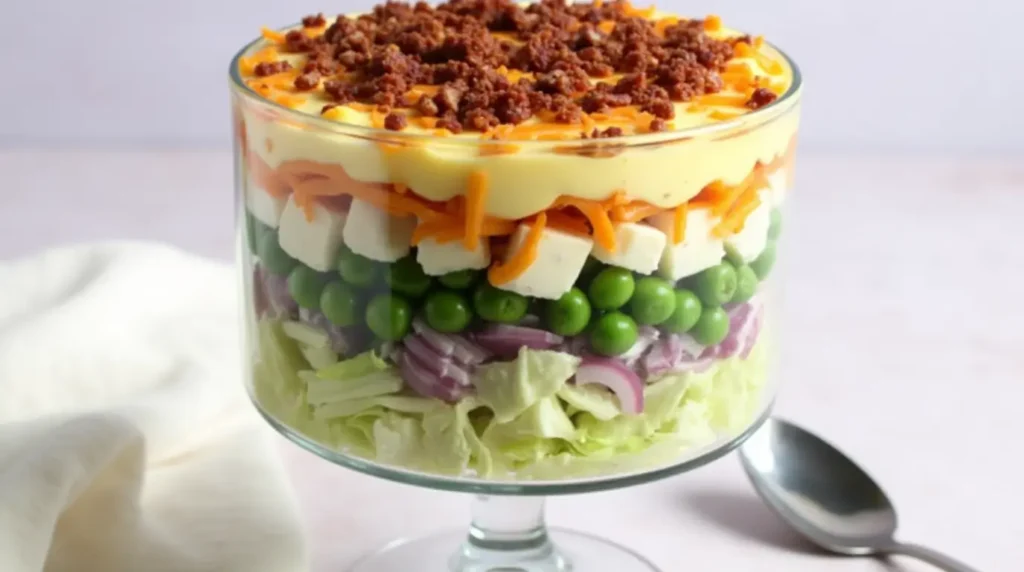
Storage and Preservation Methods
The difference between a crisp, fresh 7 layer salad and a wilted disappointment comes down to proper storage. My years of testing have helped me find the perfect preservation methods that keep every layer pristine for 24 hours or more.
Container Selection Tips
The right container is a vital part of preserving our overnight layered salad. Glass containers work better than plastic ones because they:
- Handle temperature changes better
- Don’t retain stains or odors
- Provide superior moisture control
- Offer infinite recyclability
Wide-mouth containers make filling and emptying easier. Your container’s airtight seal prevents bacteria growth and maintains proper moisture levels.
Temperature Management
Our traditional 7 layer salad recipe lasts substantially longer with perfect temperature control. Here’s my proven process:
- Store the salad at 5°C (41°F) or below
- Place in the refrigerator’s crisper drawer
- Monitor for condensation buildup
- Avoid temperature fluctuations
Proper temperature control helps your layered salad recipe stay fresh for up to five days. I suggest eating it within 24-48 hours to enjoy the best taste and texture.
Maintaining Layer Integrity
My specific techniques help maintain our 7 layer salad’s integrity right after assembly. Paper towels placed strategically – one at the container’s bottom and another on top – work wonders. This method absorbs excess moisture that could make the salad lose its crispness.
Each ingredient needs to be completely dry before layering. Your dressing creates a protective seal that keeps underlying layers fresh. Plastic wrap pressed gently against the top layer minimizes air exposure.
Room temperature shouldn’t exceed two hours at parties or picnics. Dry ingredients help extend the storage life. The drier your ingredients, the longer your salad’s texture stays appealing.
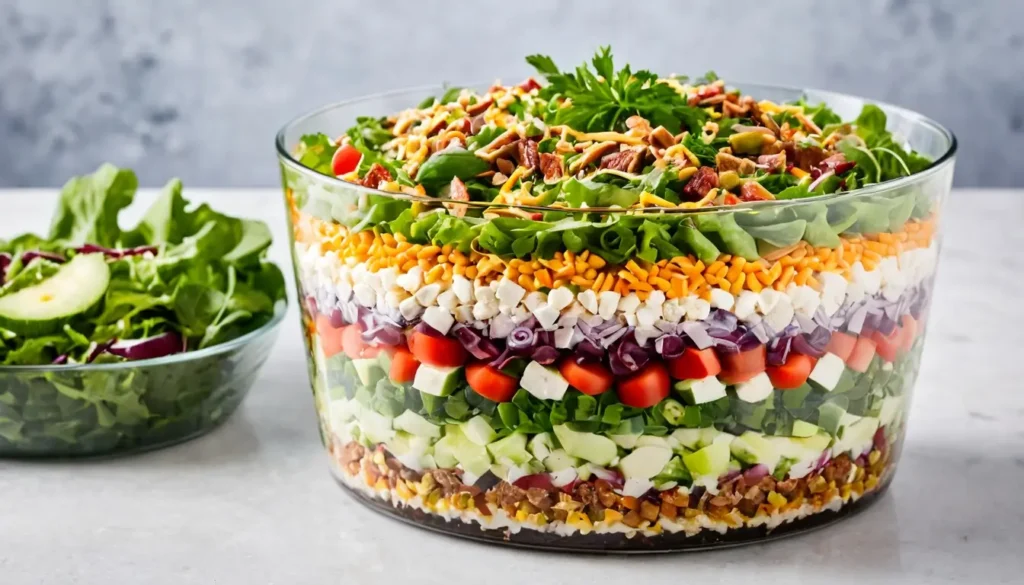
Professional Troubleshooting Guide
Making perfect 7 layer salads takes both knowledge and hands-on experience. I’ve made countless layered salads and dealt with many challenges that pop up with this classic dish.
Preventing Soggy Layers
The sort of thing I love about our traditional 7 layer salad recipe is the science behind preventing soggy layers. Salad leaves have a protective waxy cuticle layer that resists water-based liquids but easily absorbs oil. My experience shows that tossing greens with vinegar before oil creates a vital barrier that blocks oil penetration.
A proper ingredient prep combined with these proven steps will help:
- Use a salad spinner to dry lettuce completely
- Quarter tomatoes just before serving
- Remove seeds from cucumbers to reduce moisture
- Drain thawed peas completely
- Create a proper seal with the dressing layer
Fixing Common Issues
You need to know how to handle problems when they come up. Excess moisture buildup stands out as our biggest problem. This typically happens when ingredients stay wet or temperature changes cause condensation.
These solutions work best:
- Use thick dressings that stay firm over time
- Add salt only at serving time
- Put heavier ingredients at the bottom
- Keep water-heavy vegetables separate until serving
Quality Check Points
Over the last several years, I’ve developed a reliable quality control system for my overnight layered salad. Here’s everything in my checklist:
- Container Inspection
- Glass bowl for proper visibility
- Tight seal with plastic wrap
- No condensation on container walls
- Ingredient Quality
- Lettuce remains crisp and green
- Dressing maintains thickness
- Layers stay distinct and visible
- Temperature Control
- Maintain consistent refrigeration
- Serve within 24-48 hours for best results
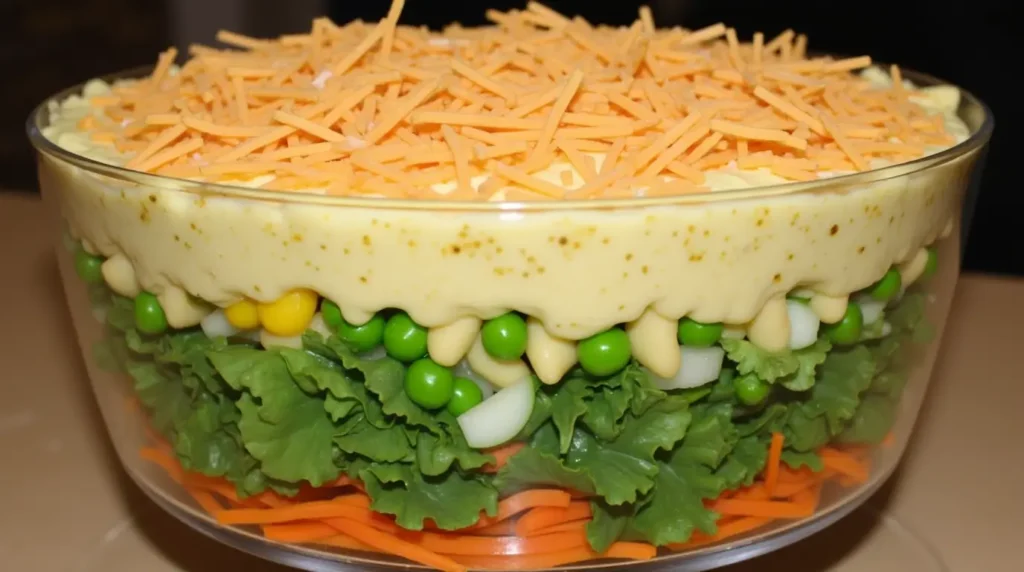
I’ve found that emulsified dressings work best to prevent wilting. The vinegar in these dressings surrounds oil droplets and keeps them from seeping into the greens that cause sogginess.
The salad stays fresh longer without sugar in the dressing layer. You can add roasted beets or red peppers for sweetness instead. This change helps maintain our 7 layer salad’s integrity while keeping its classic appeal.
Conclusion
A perfect 7-layer salad might look intimidating at first, but you’ll find endless rewards once you master it. The right layering techniques, temperature control, and storage methods will help you create an amazing dish that stays fresh and crisp for a day.
Success comes from paying attention to details – choosing quality ingredients and assembling them properly. The right moisture control through smart layering and storage temperature between 34-38°F will keep each ingredient’s texture and flavor intact.
Note that three things guarantee success: dry ingredients, proper barrier layers, and steady refrigeration. These simple yet vital steps will turn your layered salad into an impressive make-ahead dish that everyone will love.
The troubleshooting guide can help if you run into problems. Extra moisture or wrong layering cause most issues, but you’ll find quick fixes in this piece. You can find more recipes to build your cooking skills at “recipesnutritious.com“.
This classic 7-layer salad shows how good prep work and know-how can turn basic ingredients into something special. Your family and friends will definitely want seconds when you make this perfectly layered salad.
FAQs
Q1. How long can a 7 layer salad stay fresh? When properly prepared and stored, a 7 layer salad can stay fresh for up to 24 hours. For optimal taste and texture, it’s best to consume it within 24-48 hours of preparation.
Q2. What’s the best way to store a layered salad? Store the layered salad in an airtight glass container in the refrigerator at a temperature between 34-38°F (1-3°C). Place it in the crisper drawer and avoid temperature fluctuations to maintain freshness.
Q3. How can I prevent my layered salad from becoming soggy? To prevent sogginess, ensure all ingredients are thoroughly dried before assembly. Use sturdy vegetables as barrier layers, create a proper seal with the dressing layer, and avoid adding salt until serving time.
Q4. What are the key ingredients for a classic 7 layer salad? A classic 7 layer salad typically includes iceberg lettuce, frozen peas (thawed and drained), red onions, tomatoes, celery, hard-boiled eggs, and a mayonnaise-based dressing. Cheese and bacon are often added as top layers.
Q5. Can I prepare a layered salad the night before an event? Yes, you can prepare a layered salad the night before an event. In fact, allowing the salad to chill in the refrigerator for at least 4 hours or overnight allows the flavors to meld together, resulting in a more delicious salad.

